Abstract
The additive theories of behavioral contrast state that contrast will occur only when two types of responses interact during multiple schedules. Three more specific versions of the theories may be defined according to how they distinguish these two types of responses. A strong version physically distinguishes them. A second version distinguishes them according to the theoretical processes which control them. A weak version distinguishes them on the basis of the environmental relations which control them. Only the weak version of the theories is currently testable. The weak theory should be tested by establishing each of the two environmental relations independently and then combining them to assess their effect on behavior. Because this test is not usually performed, many of the results which have been taken to support or contradict the additive theories are actually ambiguous.
Keywords: behavioral contrast, additive responses, additive theories, multiple schedules, instrumental responses, pigeons, rats
Full text
PDF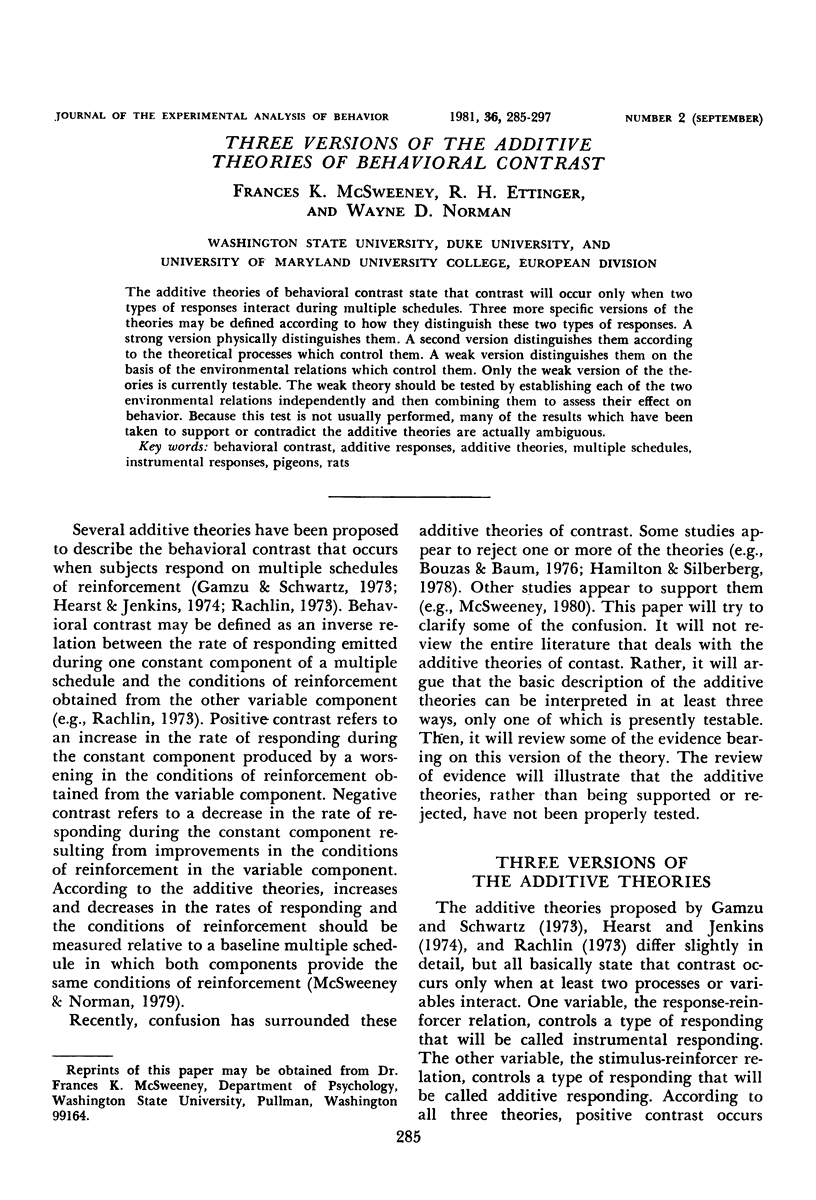
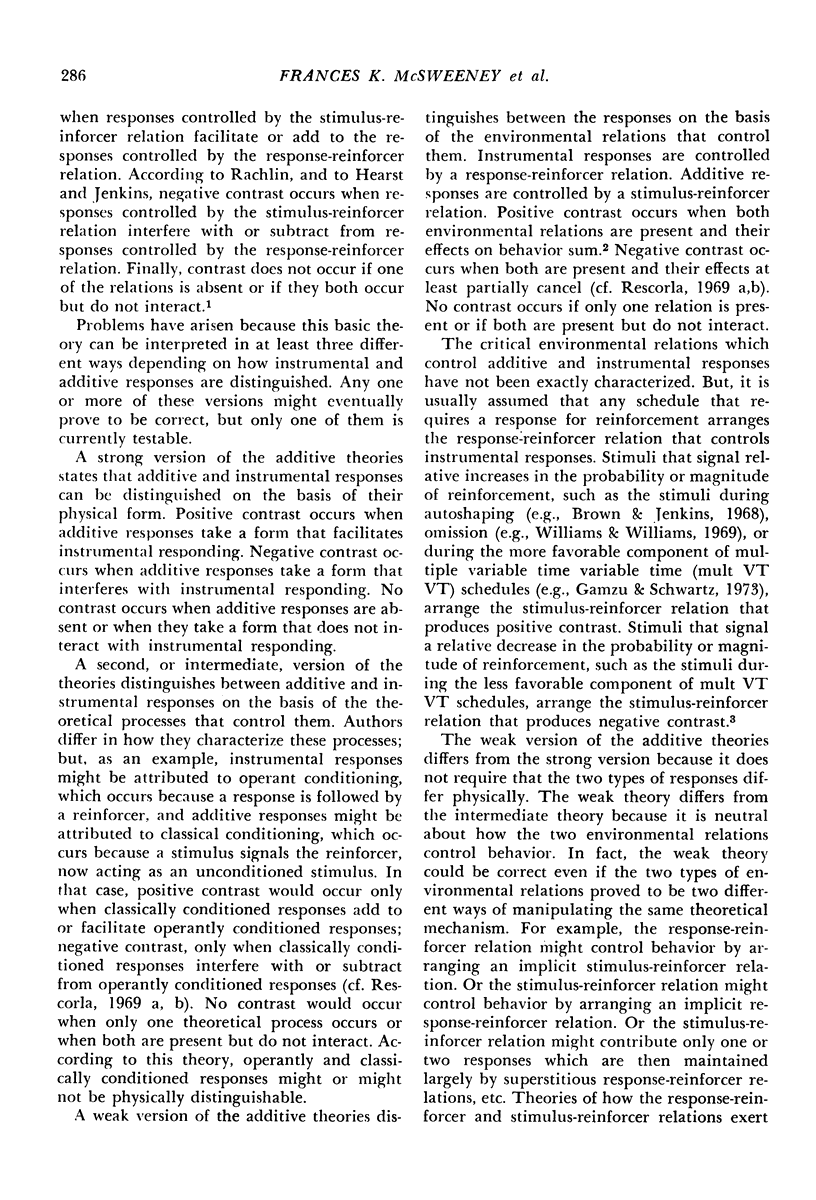
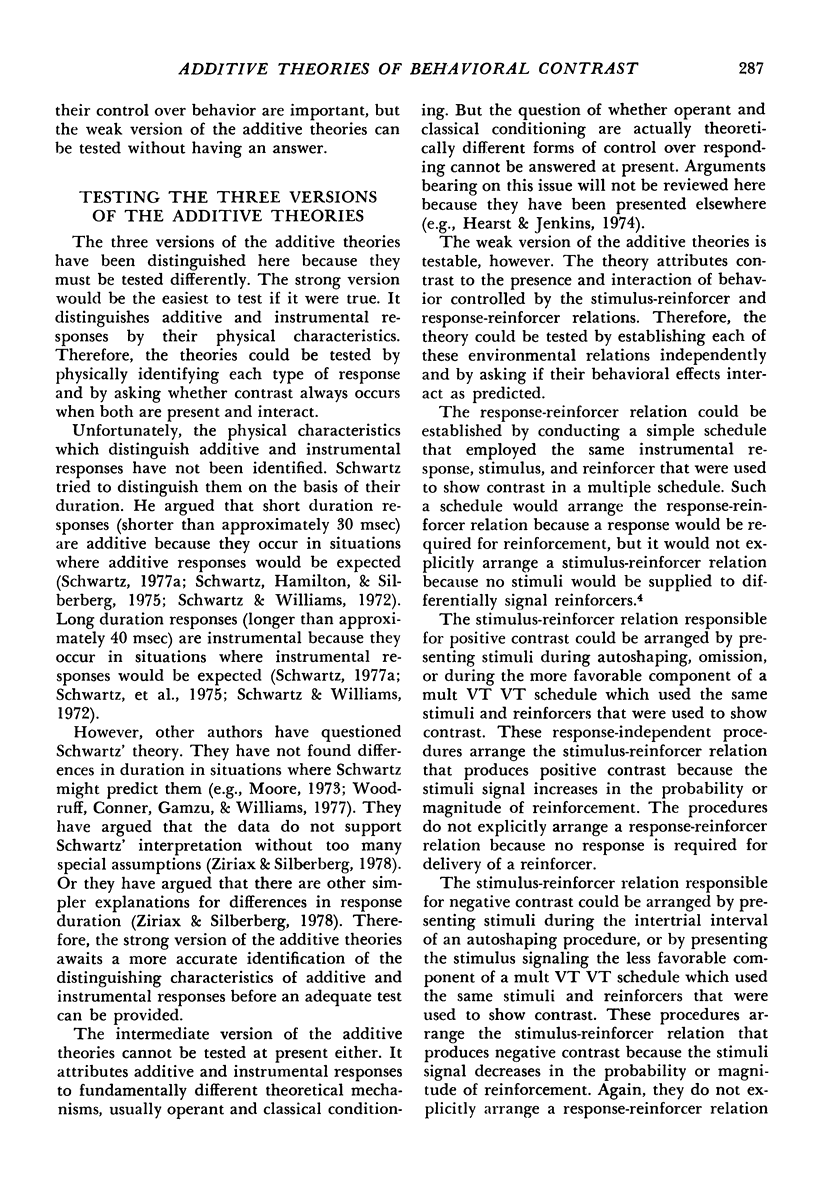
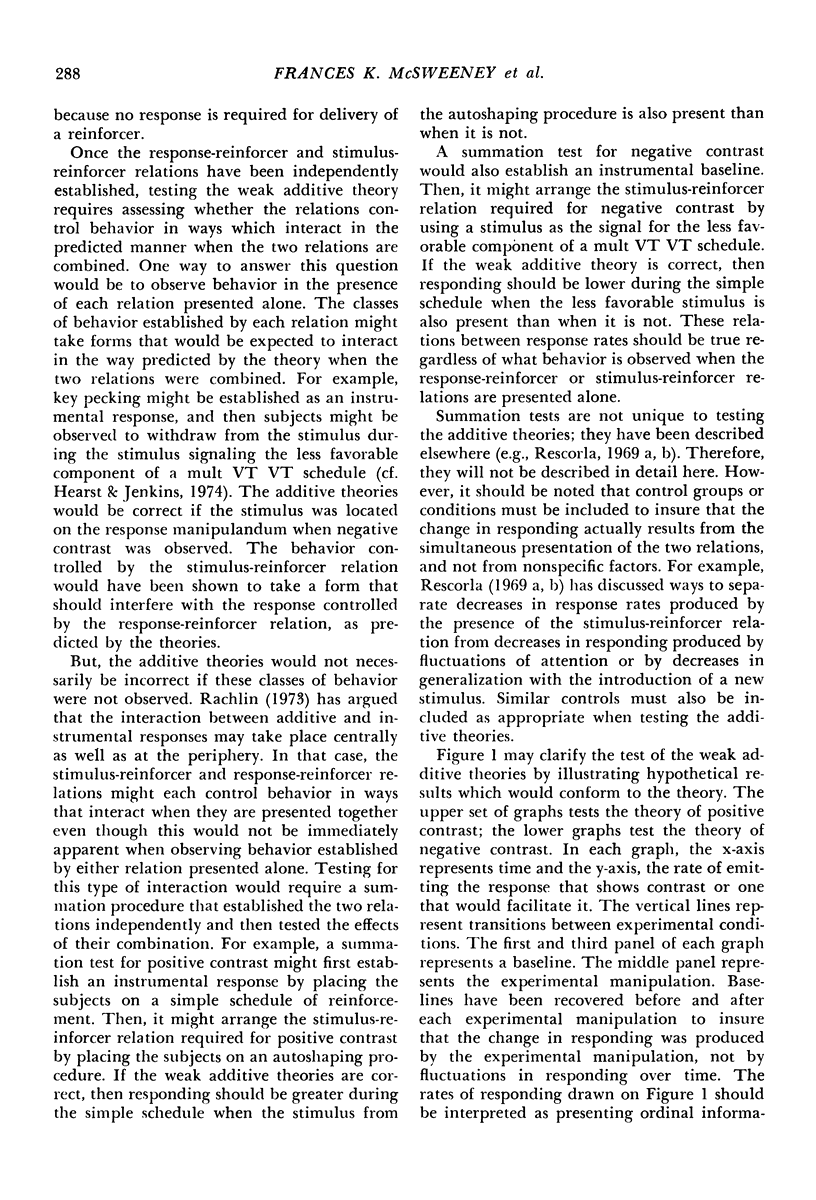
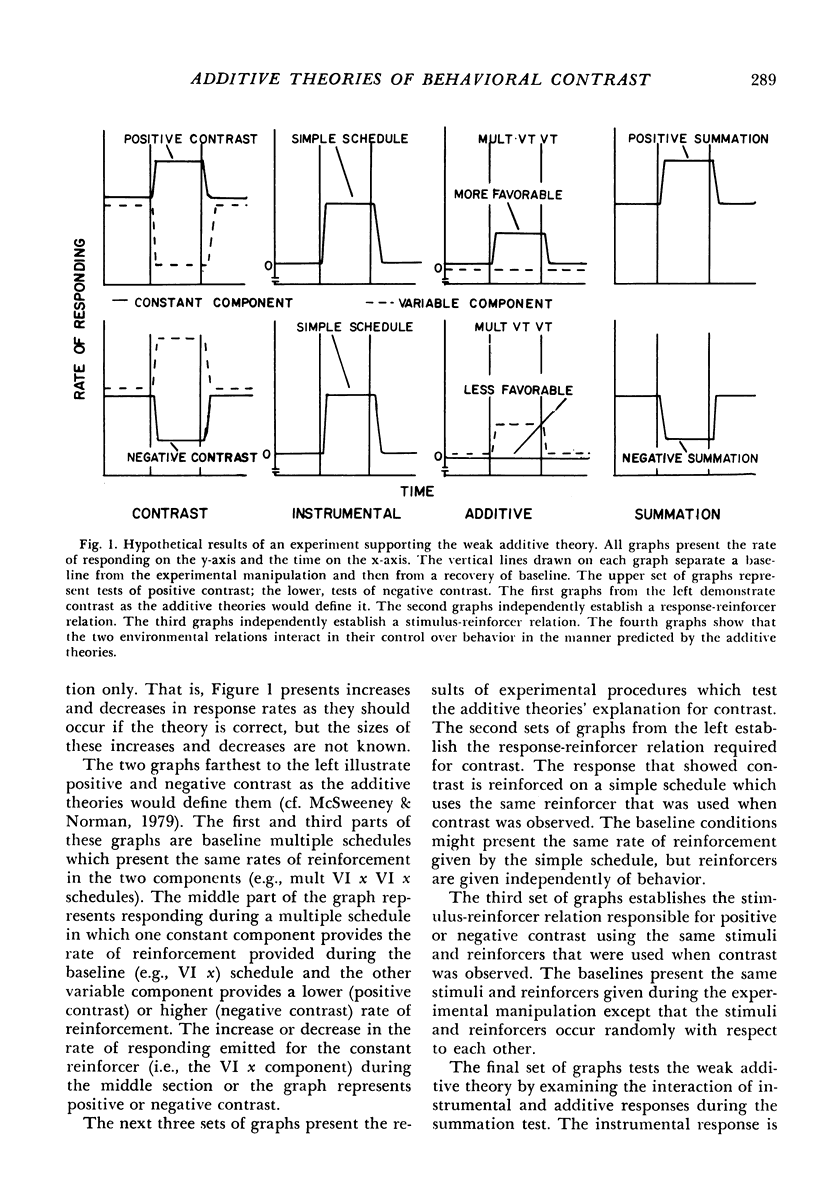
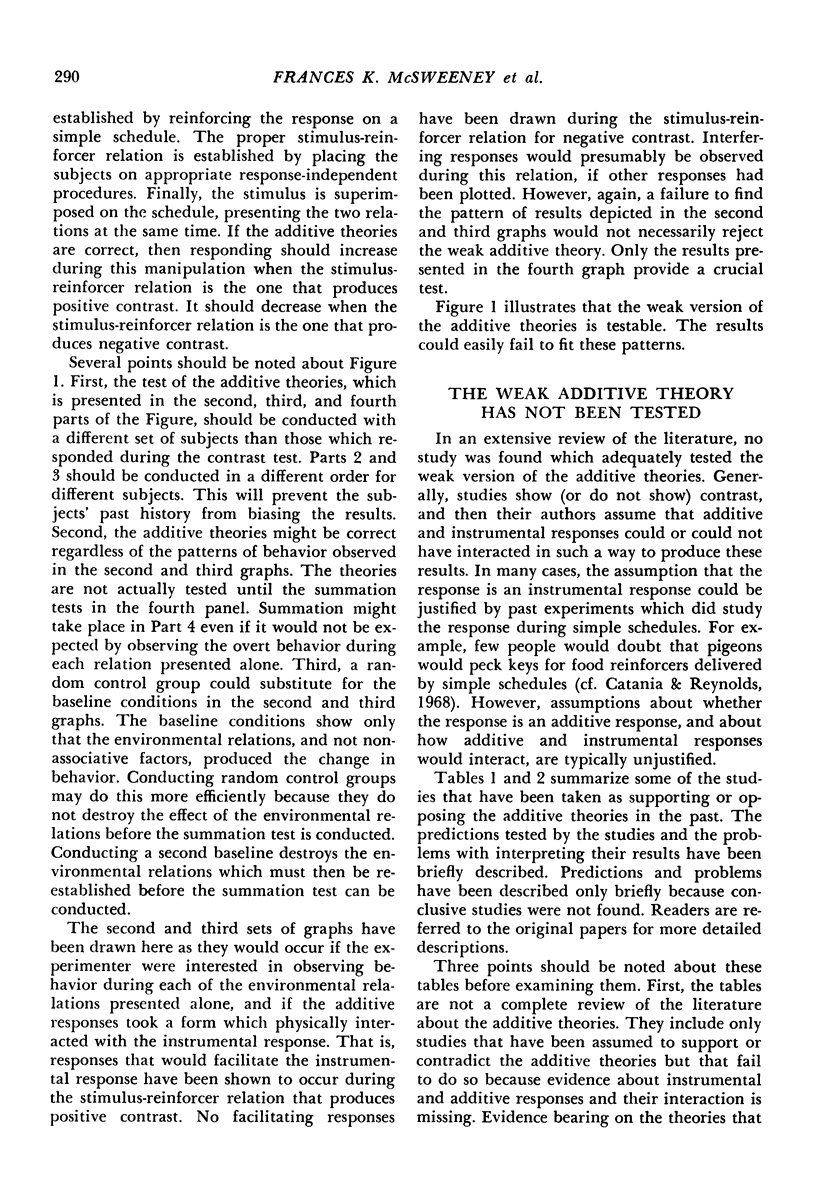
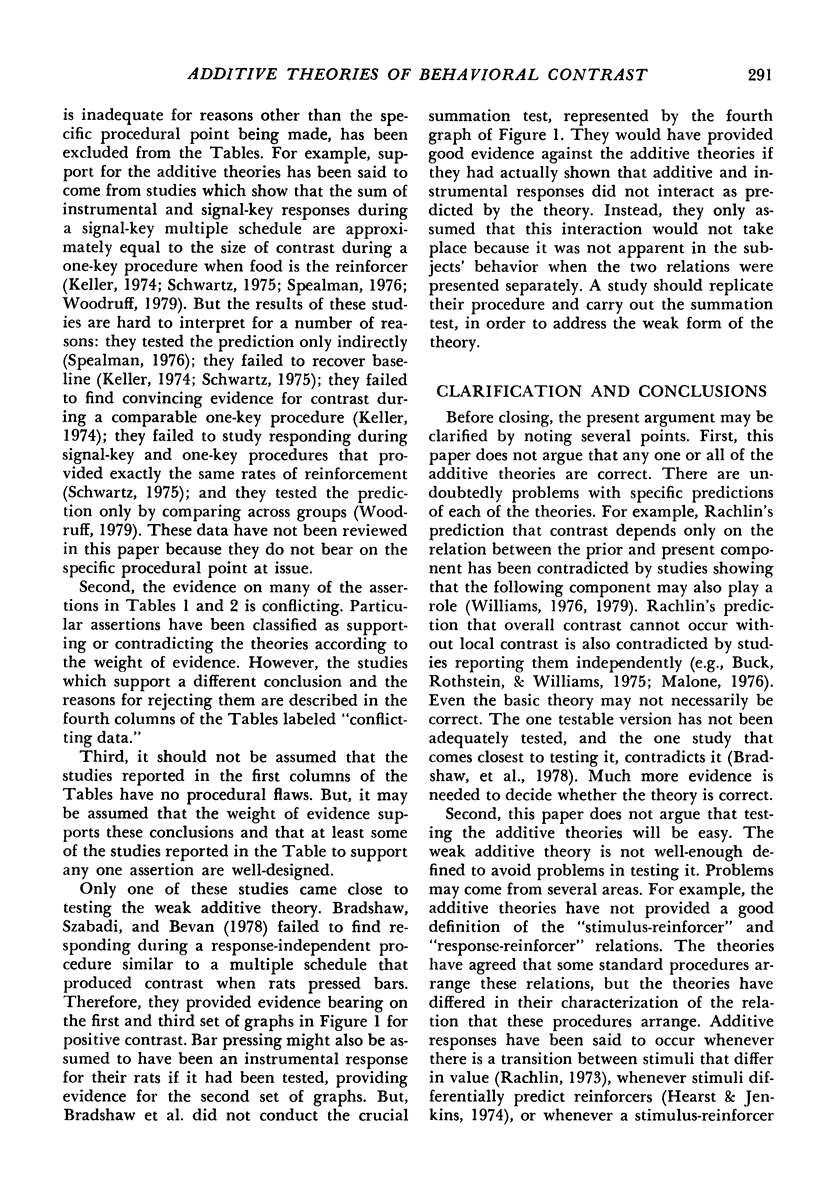
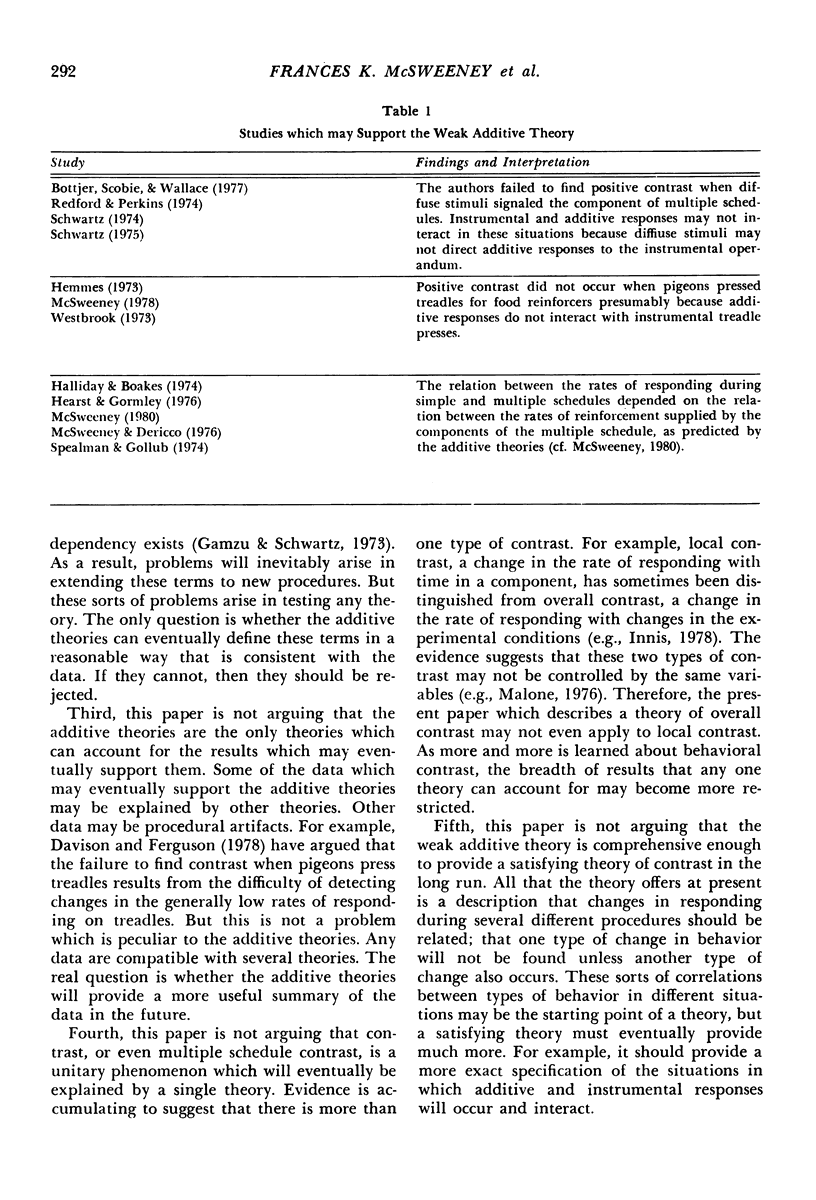

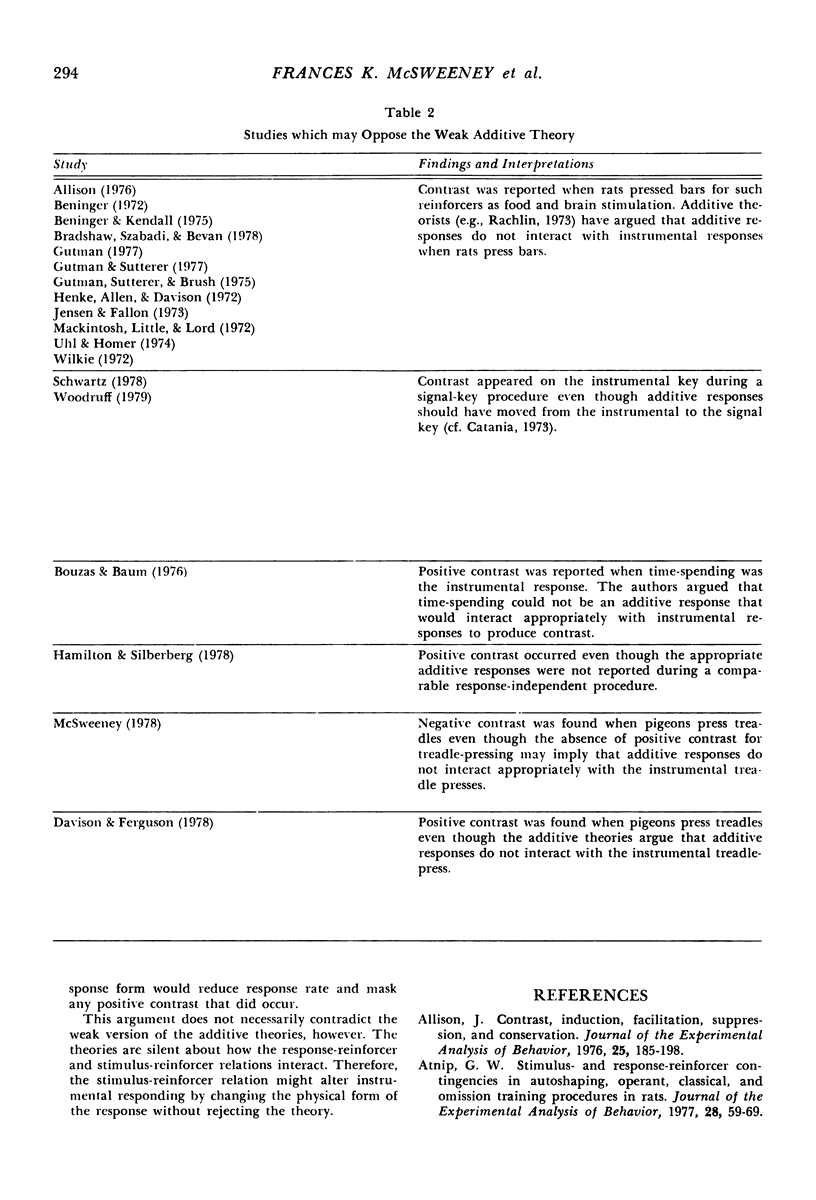
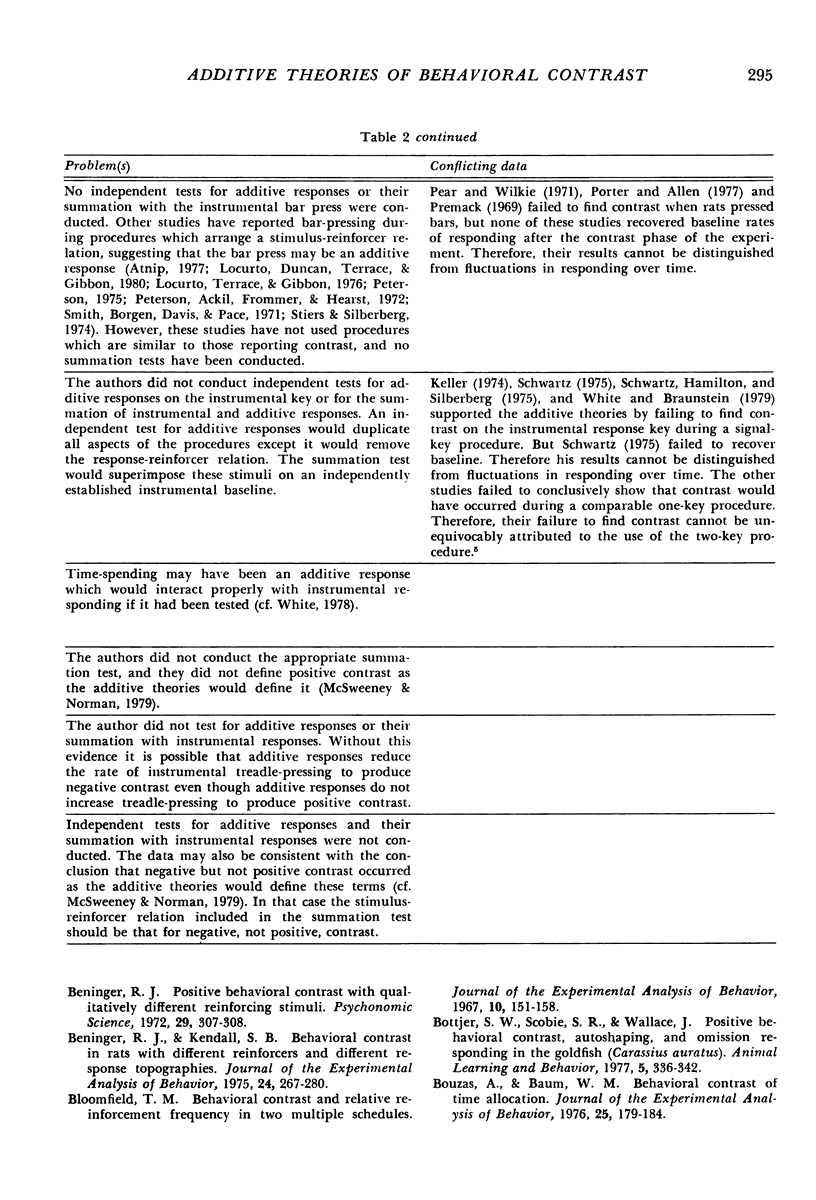
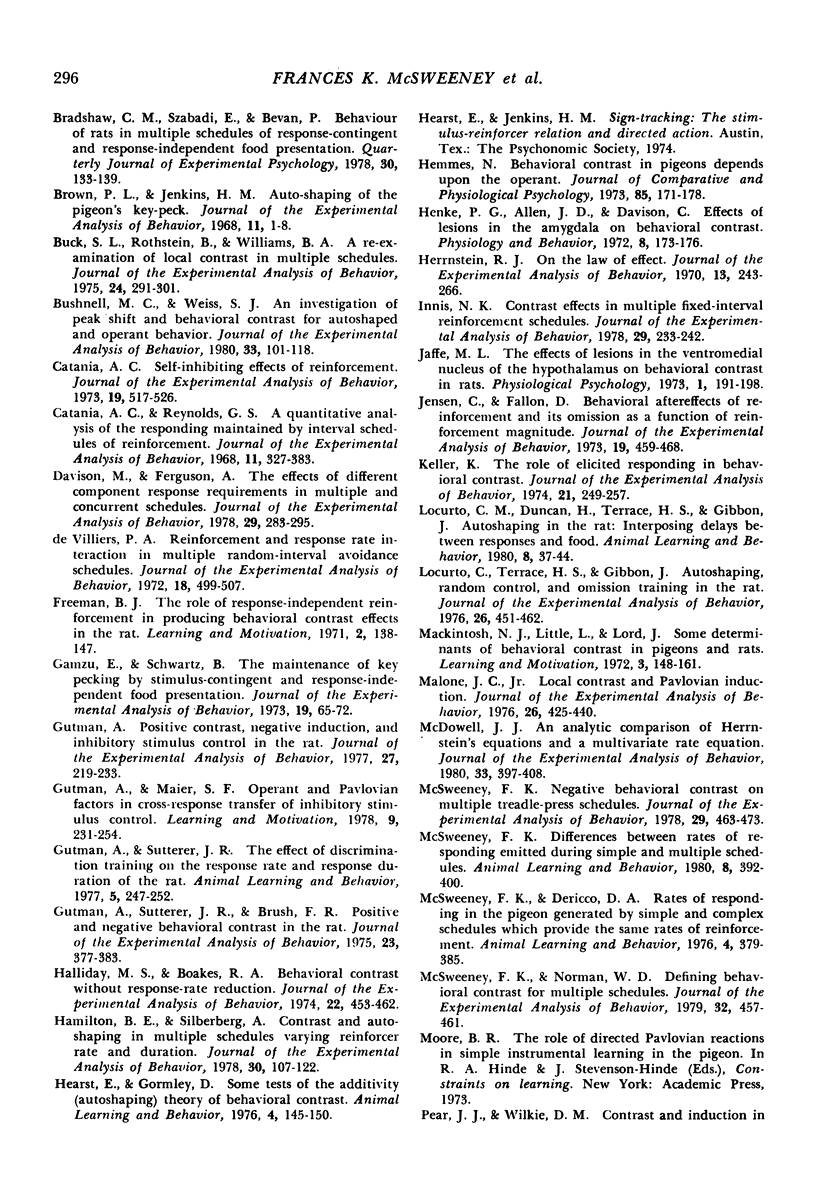
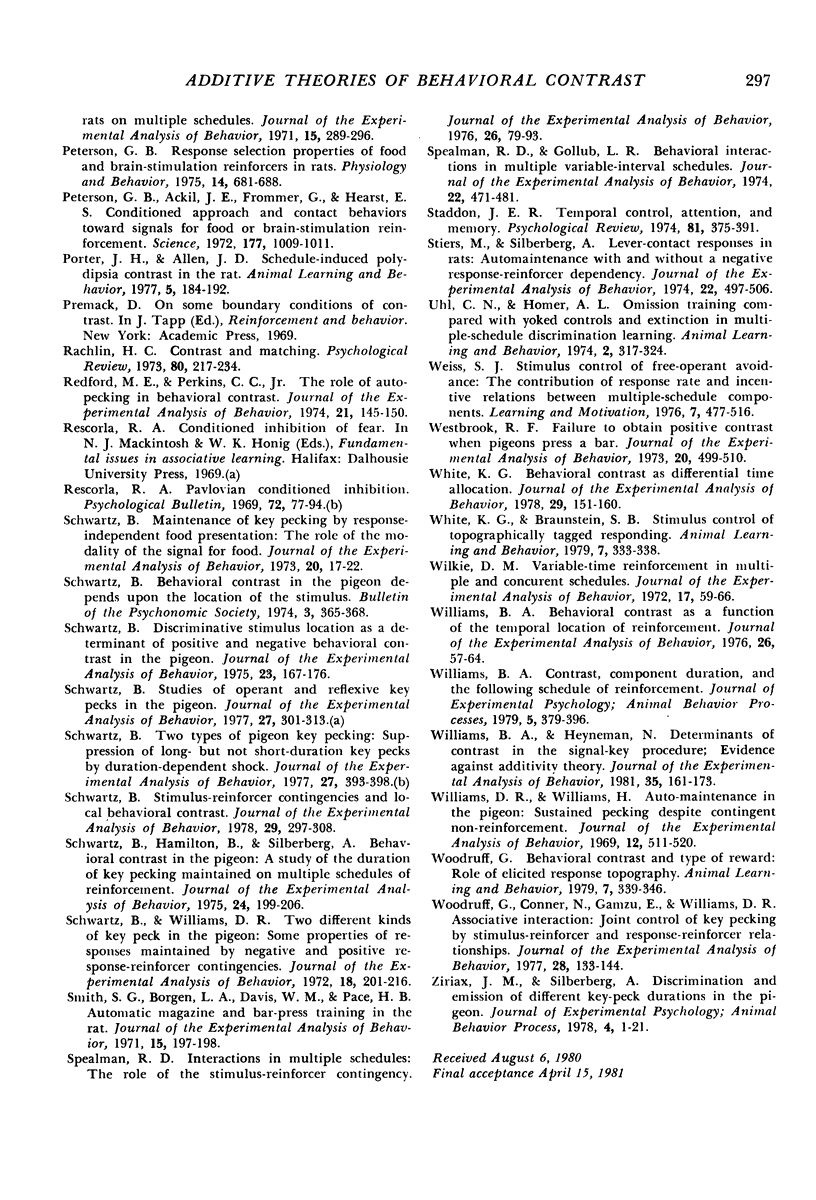
Selected References
These references are in PubMed. This may not be the complete list of references from this article.
- Allison J. Contrast, induction, facilitation, suppression, and conservation. J Exp Anal Behav. 1976 Mar;25(2):185–198. doi: 10.1901/jeab.1976.25-185. [DOI] [PMC free article] [PubMed] [Google Scholar]
- Atnip G. W. Stimulus- and response-reinforcer contingencies in autoshaping, operant, classical, and omission training procedures in rats. J Exp Anal Behav. 1977 Jul;28(1):59–69. doi: 10.1901/jeab.1977.28-59. [DOI] [PMC free article] [PubMed] [Google Scholar]
- Beninger R. J., Kendall S. B. Behavioral contrast in rats with different reinforcers and different response topographies. J Exp Anal Behav. 1975 Nov;24(3):267–280. doi: 10.1901/jeab.1975.24-267. [DOI] [PMC free article] [PubMed] [Google Scholar]
- Bloomfield T. M. Behavioral contrast and relative reinforcement frequency in two multiple schedules. J Exp Anal Behav. 1967 Mar;10(2):151–158. doi: 10.1901/jeab.1967.10-151. [DOI] [PMC free article] [PubMed] [Google Scholar]
- Bouzas A., Baum W. M. Behavioral contrast of time allocation. J Exp Anal Behav. 1976 Mar;25(2):179–184. doi: 10.1901/jeab.1976.25-179. [DOI] [PMC free article] [PubMed] [Google Scholar]
- Brown P. L., Jenkins H. M. Auto-shaping of the pigeon's key-peck. J Exp Anal Behav. 1968 Jan;11(1):1–8. doi: 10.1901/jeab.1968.11-1. [DOI] [PMC free article] [PubMed] [Google Scholar]
- Buck S. L., Rothstein B., Williams B. A. A re-examination of local contrast in multiple schedules. J Exp Anal Behav. 1975 Nov;24(3):291–301. doi: 10.1901/jeab.1975.24-291. [DOI] [PMC free article] [PubMed] [Google Scholar]
- Bushnell M. C., Weiss S. J. An investigation of peak shift and behavioral contrast for autoshaped and operant behavior. J Exp Anal Behav. 1980 Jan;33(1):101–118. doi: 10.1901/jeab.1980.33-101. [DOI] [PMC free article] [PubMed] [Google Scholar]
- Catania A. C., Reynolds G. S. A quantitative analysis of the responding maintained by interval schedules of reinforcement. J Exp Anal Behav. 1968 May;11(3 Suppl):327–383. doi: 10.1901/jeab.1968.11-s327. [DOI] [PMC free article] [PubMed] [Google Scholar]
- Catania A. C. Self-inhibiting effects of reinforcement. J Exp Anal Behav. 1973 May;19(3):517–526. doi: 10.1901/jeab.1973.19-517. [DOI] [PMC free article] [PubMed] [Google Scholar]
- Davison M., Ferguson A. The effects of different component response requirements in multiple and concurrent schedules. J Exp Anal Behav. 1978 Mar;29(2):283–295. doi: 10.1901/jeab.1978.29-283. [DOI] [PMC free article] [PubMed] [Google Scholar]
- De Villiers P. A. Reinforcement and response rate interaction in multiple random-interval avoidance schedules. J Exp Anal Behav. 1972 Nov;18(3):499–507. doi: 10.1901/jeab.1972.18-499. [DOI] [PMC free article] [PubMed] [Google Scholar]
- Gamzu E., Schwartz B. The maintenance of key pecking by stimulus-contingent and response-independent food presentation. J Exp Anal Behav. 1973 Jan;19(1):65–72. doi: 10.1901/jeab.1973.19-65. [DOI] [PMC free article] [PubMed] [Google Scholar]
- Gutman A. Positive contrast, negative induction, and inhibitory stimulus control in the rat. J Exp Anal Behav. 1977 Mar;27(2):219–233. doi: 10.1901/jeab.1977.27-219. [DOI] [PMC free article] [PubMed] [Google Scholar]
- Gutman A., Sutterer J. R., Brush F. R. Positive and negative behavioral contrast in the rat. J Exp Anal Behav. 1975 May;23(3):377–383. doi: 10.1901/jeab.1975.23-377. [DOI] [PMC free article] [PubMed] [Google Scholar]
- Halliday M. S., Boakes R. A. Behavioral contrast without response-rate reduction. J Exp Anal Behav. 1974 Nov;22(3):453–462. doi: 10.1901/jeab.1974.22-453. [DOI] [PMC free article] [PubMed] [Google Scholar]
- Hamilton B. E., Silberberg A. Contrast and autoshaping in multiple schedules varying reinforcer rate and duration. J Exp Anal Behav. 1978 Jul;30(1):107–122. doi: 10.1901/jeab.1978.30-107. [DOI] [PMC free article] [PubMed] [Google Scholar]
- Hearst E., Gormley D. Some tests of the additivity (autoshaping) theory of behavioral contrast. Anim Learn Behav. 1976 May;4(2):145–150. doi: 10.3758/bf03214025. [DOI] [PubMed] [Google Scholar]
- Hemmes N. S. Behavioral contrast in pigeons depends upon the operant. J Comp Physiol Psychol. 1973 Oct;85(1):171–178. doi: 10.1037/h0034883. [DOI] [PubMed] [Google Scholar]
- Henke P. G., Allen J. D., Davison C. Effect of lesions in the amygdala on behavioral contrast. Physiol Behav. 1972 Feb;8(2):173–176. doi: 10.1016/0031-9384(72)90356-3. [DOI] [PubMed] [Google Scholar]
- Herrnstein R. J. On the law of effect. J Exp Anal Behav. 1970 Mar;13(2):243–266. doi: 10.1901/jeab.1970.13-243. [DOI] [PMC free article] [PubMed] [Google Scholar]
- Innis N. K. Contrast effects in multiple fixed-interval reinforcement schedules. J Exp Anal Behav. 1978 Mar;29(2):233–242. doi: 10.1901/jeab.1978.29-233. [DOI] [PMC free article] [PubMed] [Google Scholar]
- Jensen C., Fallon D. Behavioral aftereffects of reinforcement and its omission as a function of reinforcement magnitude. J Exp Anal Behav. 1973 May;19(3):459–468. doi: 10.1901/jeab.1973.19-459. [DOI] [PMC free article] [PubMed] [Google Scholar]
- Keller K. The role of elicited responding in behavioral contrast. J Exp Anal Behav. 1974 Mar;21(2):249–257. doi: 10.1901/jeab.1974.21-249. [DOI] [PMC free article] [PubMed] [Google Scholar]
- Locurto C., Terrace H. S., Gibbon J. Autoshaping, random control, and omission training in the rat. J Exp Anal Behav. 1976 Nov;26(3):451–462. doi: 10.1901/jeab.1976.26-451. [DOI] [PMC free article] [PubMed] [Google Scholar]
- Malone J. C. Local contrast and Pavlovian induction. J Exp Anal Behav. 1976 Nov;26(3):425–440. doi: 10.1901/jeab.1976.26-425. [DOI] [PMC free article] [PubMed] [Google Scholar]
- McDowell J. J. An analytic comparison of Herrnstein's equations and a multivariate rate equation. J Exp Anal Behav. 1980 May;33(3):397–408. doi: 10.1901/jeab.1980.33-397. [DOI] [PMC free article] [PubMed] [Google Scholar]
- McSweeney F. K. Negative behavioral contrast on multiple treadle-press schedules. J Exp Anal Behav. 1978 May;29(3):463–473. doi: 10.1901/jeab.1978.29-463. [DOI] [PMC free article] [PubMed] [Google Scholar]
- McSweeney F. K., Norman W. D. Defining behavioral contrast for multiple schedules. J Exp Anal Behav. 1979 Nov;32(3):457–461. doi: 10.1901/jeab.1979.32-457. [DOI] [PMC free article] [PubMed] [Google Scholar]
- Pear J. J., Wilkie D. M. Contrast and induction in rats on multiple schedules. J Exp Anal Behav. 1971 May;15(3):289–296. doi: 10.1901/jeab.1971.15-289. [DOI] [PMC free article] [PubMed] [Google Scholar]
- Peterson G. B., Ackilt J. E., Frommer G. P., Hearst E. S. Conditioned Approach and Contact Behavior toward Signals for Food or Brain-Stimulation Reinforcement. Science. 1972 Sep 15;177(4053):1009–1011. doi: 10.1126/science.177.4053.1009. [DOI] [PubMed] [Google Scholar]
- Peterson G. B. Response selection properties of food and brain-stimulation reinforcers in rats. Physiol Behav. 1975 Jun;14(6):681–688. doi: 10.1016/0031-9384(75)90058-x. [DOI] [PubMed] [Google Scholar]
- Redford M. E., Perkins C. C. The role of autopecking in behavioral contrast. J Exp Anal Behav. 1974 Jan;21(1):145–150. doi: 10.1901/jeab.1974.21-145. [DOI] [PMC free article] [PubMed] [Google Scholar]
- Schwartz B. Discriminative stimulus location as a determinant of positive and negative behavioral contrast in the pigeon. J Exp Anal Behav. 1975 Mar;23(2):167–176. doi: 10.1901/jeab.1975.23-167. [DOI] [PMC free article] [PubMed] [Google Scholar]
- Schwartz B., Hamilton B., Silberberg A. Behavioral contrast in the pigeon: a study of the duration of key pecking maintained on multiple schedules of reinforcement. J Exp Anal Behav. 1975 Sep;24(2):199–206. doi: 10.1901/jeab.1975.24-199. [DOI] [PMC free article] [PubMed] [Google Scholar]
- Schwartz B. Maintenance of key pecking by response-independent food presentation: the role of the modality of the signal for food. J Exp Anal Behav. 1973 Jul;20(1):17–22. doi: 10.1901/jeab.1973.20-17. [DOI] [PMC free article] [PubMed] [Google Scholar]
- Schwartz B. Stimulus-reinforcer contingencies and local behavioral contrast. J Exp Anal Behav. 1978 Mar;29(2):297–308. doi: 10.1901/jeab.1978.29-297. [DOI] [PMC free article] [PubMed] [Google Scholar]
- Schwartz B. Studies of operant and reflexive key pecks in the pigeon. J Exp Anal Behav. 1977 Mar;27(2):301–313. doi: 10.1901/jeab.1977.27-301. [DOI] [PMC free article] [PubMed] [Google Scholar]
- Schwartz B. Two types of pigeon key pecking: suppression of long- but not short-duration key pecks by duration-dependent shock. J Exp Anal Behav. 1977 Mar;27(2):393–398. doi: 10.1901/jeab.1977.27-393. [DOI] [PMC free article] [PubMed] [Google Scholar]
- Schwartz B., Williams D. R. Two different kinds of key peck in the pigeon: some properties of responses maintained by negative and positive response-reinforcer contingencies. J Exp Anal Behav. 1972 Sep;18(2):201–216. doi: 10.1901/jeab.1972.18-201. [DOI] [PMC free article] [PubMed] [Google Scholar]
- Smith S. G., Borgen L. A., Davis W. M., Pace H. B. Automatic magazine and bar-press training in the rat. J Exp Anal Behav. 1971 Mar;15(2):197–198. doi: 10.1901/jeab.1971.15-197. [DOI] [PMC free article] [PubMed] [Google Scholar]
- Spealman R. D., Gollub L. R. Behavioral interactions in multiple variable-interval schedules. J Exp Anal Behav. 1974 Nov;22(3):471–481. doi: 10.1901/jeab.1974.22-471. [DOI] [PMC free article] [PubMed] [Google Scholar]
- Spealman R. D. Interactions in multiple schedules: the role of the stimulus-reinforcer contingency. J Exp Anal Behav. 1976 Jul;26(1):79–93. doi: 10.1901/jeab.1976.26-79. [DOI] [PMC free article] [PubMed] [Google Scholar]
- Stiers M., Silberberg A. Lever-contact responses in rats: automaintenance with and without a negative response-reinforcer dependency. J Exp Anal Behav. 1974 Nov;22(3):497–506. doi: 10.1901/jeab.1974.22-497. [DOI] [PMC free article] [PubMed] [Google Scholar]
- White K. G. Behavioral contrast as differential time allocation. J Exp Anal Behav. 1978 Mar;29(2):151–160. doi: 10.1901/jeab.1978.29-151. [DOI] [PMC free article] [PubMed] [Google Scholar]
- Wilkie D. M. Variable-time reinforcement in multiple and concurrent schedules. J Exp Anal Behav. 1972 Jan;17(1):59–66. doi: 10.1901/jeab.1972.17-59. [DOI] [PMC free article] [PubMed] [Google Scholar]
- Williams B. A. Behavioral contrast as a function of the temporal location of reinforcement. J Exp Anal Behav. 1976 Jul;26(1):57–64. doi: 10.1901/jeab.1976.26-57. [DOI] [PMC free article] [PubMed] [Google Scholar]
- Williams B. A., Heyneman N. Determinants of contrast in the signal-key procedure: Evidence against additivity theory. J Exp Anal Behav. 1981 Mar;35(2):161–173. doi: 10.1901/jeab.1981.35-161. [DOI] [PMC free article] [PubMed] [Google Scholar]
- Williams D. R., Williams H. Auto-maintenance in the pigeon: sustained pecking despite contingent non-reinforcement. J Exp Anal Behav. 1969 Jul;12(4):511–520. doi: 10.1901/jeab.1969.12-511. [DOI] [PMC free article] [PubMed] [Google Scholar]
- Woodruff G., Conner N., Gamzu E., Williams D. R. Associative interaction: joint control of key pecking by stimulus-reinforcer and response-reinforcer relationships. J Exp Anal Behav. 1977 Sep;28(2):133–144. doi: 10.1901/jeab.1977.28-133. [DOI] [PMC free article] [PubMed] [Google Scholar]


